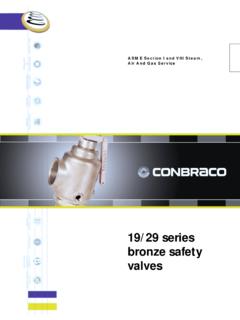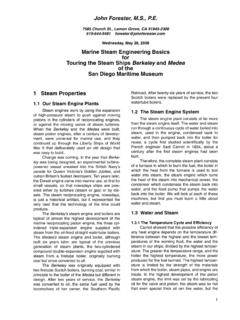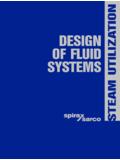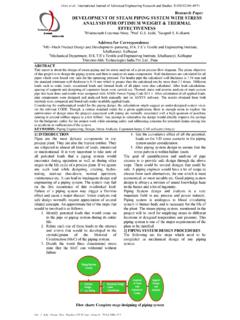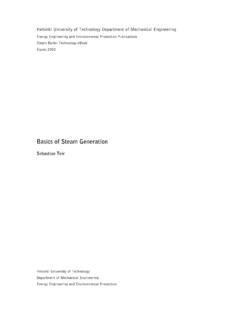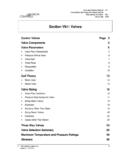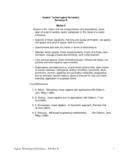Transcription of BASICS OF STEAM TRAPS - Steam Specialty
1 BASICS OFSTEAMTRAPSWHY DO WE NEED STEAM TRAPS ?In order to operate economically andefficiently, all STEAM systems must beprotected against 3 factors:* CONDENSATE* AIR* NON-CONDENSIBLESC ondensateis formed in a systemwhenever STEAM gives up its useableheat. And, since condensate interfereswith the efficiency of the operation of asteam system, it must be , one of natures finest insulators,when mixed with STEAM , will lower itstemperature and hinder the the overalleffectiveness of an entire system. Forexample: A film of air 1/1000th of aninch thick offers as much resistance toheat transfer as 13" of copper or 3 ofsteel. For that reason, air MUST becontinuously bled from a system bysteam TRAPS to have it operateefficiently and to conserve , such as carbondioxide promote corrosion and otherdeterioration of equipment and inhibittheir IS A STEAM TRAP?
2 A STEAM trap is basically an automaticvalve which discharges condensate,undesirable air and non-condensiblesfrom a system while trapping, or holdingin, STEAM . They fall into 4 major cate-gories; Thermostatic, Mechanical,Thermodynamic and Drain type will be discussed in detail inthis every STEAM system, there are fourphases of operation in which TRAPS playa vital role:1) Start-up During start-up , when thesystem is initially activated, air andnon-condensibles must be ) Heat-up During heat-up , as thesystem works to achieve the desiredtemperature and pressure,condensateis ) At Temperature At temperature ,when the desired levels are reached,the valve must close to retain ) Using Heat At the using heat level, the valve's job is to stay closedunless and until condensateoccurs;then the valve must open, dischargethe condensate and close quickly andpositively, without allowing valuablesteam to ARE THE QUALITIES OF AGOOD STEAM TRAP?
3 A good STEAM trap should: Discharge condensate, air andnon-condensibles. Be equal to the load over a widerange of pressures andtemperatures. Be freeze-proof wherenecessary. Be simple and rugged. Have few moving parts. Require low maintenance andspare parts inventory. Have a long good STEAM trap should not: Discharge live STEAM . Fail or malfunction if pressurechanges. Respond slowly or hesitantly. Open too often, too briefly or fortoo long. Require constant adjustment orfrequent repair. Require a wide variety of models,spare parts or orifice sizes fordifferent STEAM TRAPS , as their nameimplies, operate in direct response tothe temperature within the trap. Thereare two primary types: TRAPSOf all actuating devices, the bellows trapmost nearly approaches ideal operationand efficiency and is most is positive in both directions, is fastacting and does not require TRAPS employ only one movingpart - a liquid filled metal bellows -which responds quickly and preciselyto the presence or absence of startup and warmup, a vacuumin the bellows keeps it retracted, withthe valve lifted well clear of the seatpermitting air and non-condensibles tobe freely discharged (Figure 13).
4 Next, condensate is discharged (Figure14). Then heat from arriving STEAM willcause the liquid in the bellows to vapor-ize and close the valve (Figure 15).At temperature, the valve will remainclosed indefinitely opening only whencondensate, air or other non-conden-sibles cause it to retract and live STEAM re-enters the traphousing, the bellows extends immedi-ately, trapping the STEAM (Figure 15).The bellows, unlike a disc trap, is atemperature sensitive rather than a timecycle device. There is no way that aircan be mistaken for STEAM and causebinding, since bellows react totemperature only. And unlike buckettraps, bellows TRAPS do not require avariety of sizes for valves and seats forvarious TRAPSB imetallic TRAPS work like the differentialmetal strip in a thermostat, using theunequal expansion of two differentmetals to produce movement whichopens and closes a 16: When the cooler condensatecontacts the bimetallic discs, the discsrelax.
5 Inlet pressure forces the valve awayfrom its seat and permits 17: When STEAM enters the trapand heats the bimetallic discs, thediscs expand forcing the valve againstits seat preventing TRAPS are simple and positivein both directions. However, they havea built-in delay factor which makesthem inherently sluggish. Moreover;they do not maintain their originalsettings because the elements tend totake a permanent set after use, whichrequires repeated adjustment tomaintain bottom and the valve (B) fully opento allow condensate to flow out freely. There are two basic types of mechan-ical STEAM TRAPS :1) FLOAT & THERMOSTATIC 2) INVERTED BUCKETI nverted bucket TRAPS , as their namesuggests, operate like an upside downbucket in 1: During startup, the trap isfilled with water, with the bucket (A) atFigure 2:Air trapped in the bucketescapes through a vent hole (C).
6 OnFIGURE 13 FIGURE 14 FIGURE 15 FIGURE 16 FIGURE 17 FIGURE 1 FIGURE 2 MECHANICALSTEAMTRAPSMECHANICALSTEAMTRAPS CONT buckets, an additional vent holeis controlled by a bimetallicstrip whichis kept closed by the STEAM . Therefore,the vent only operates during limits bucket trap air handlingcapacity. Figure 3:At temperature, STEAM entersunder the bucket and causes it to floatup and close the valve (B). During heatuse, any condensate entering the line isforced up into the bucket. The bucketlooses buoyancy and drops down,reopening the valveand discharging thecondensate. (see Figure 1)Bucket TRAPS are rugged and reliable,however, air building up in the bucketcan bind them closed causing conden-sate to back up in the line. Also, theycan waste STEAM if they lose their prime(see Figure 4). Bucket TRAPS requirepriming water in the trap which makesthem vulnerable to freeze up unlessexpensive insulation is bucket TRAPS rely on a fixedforce, the weight of the bucket, dischargeorifices must be sized by pressure.
7 Forexample, a trap sized to operate at 50 PSIG will not open at 150 TRAPS are manufactured in avariety of sizes, shapes and configur-ations. The most commonly used (forsteam service) is the float and thermo-static, or F & T. F & T TRAPS combinethe excellent air venting capabilities ofa thermostatic trap with the liquid levelcontrolling capabilities of a float 5:During startup, before conden-sate reaches the trap, the thermostaticelement is fully open to discharge air. Thefloat rests on the lower 6:As hot condensate and steamreach the trap, the thermostatic elementexpands, closing the air vent. Conden-sate lifts the float, allowing condensateto flow out of the 7:As the condensing ratedecreases, the float lowers, reducingflow through the trap. The buoyancy ofthe float will maintain a liquid level sealabove the lower seat ring, preventingthe escape of STEAM .
8 As with invertedbucket TRAPS , float and thermostatictraps rely on a fixed force (the buoyancyof the float). Discharge orifices must besized by differential pressure. Placing alow pressure float and thermostatictrap in high pressure service will resultin the trap locking up. A contrastingcharacteristic of both the float andthermostatic and inverted bucket is thedischarge cycle. A float & thermostatictrap tends to continuously dischargecondensate while the inverted buckettrap discharges condensate in 4 FIGURE 3 FIGURE 7 FIGURE 6 FIGURE 5 THERMODYNAMICSTEAMTRAPSE ssentially, a thermodynamic STEAM trapis a time cycle device which respondsto imbalances of pressure applied to avalving device, usually a 9:Pressure caused by air orcondensate lifts the disc permittingflow through the 10:When STEAM arrives at theinlet port, blowby at a high velocitycreates low pressure under the of the flashing condensate isblown past the disc into the upperchamber, forcing the disc 11:Further flow is stoppedwhen sufficient pressure is trapped inthe chamber above the disc.
9 Duringoperation, a decrease in chamberpressure permits inlet pressure to liftthe disc and open the trap (Figure 9).The decrease in the chamber pressureshould only be caused by the presenceof cooler condensate. Due to thedesign of most thermodynamic TRAPS ,especially in cold or wet conditions, thechamber may be prematurely cooledcausing improper or frequent cycling aswell as STEAM loss and increased TD designs have a steamjacket which surrounds the chamberand prevents ambient conditionsaffecting the operation of the type of trap is also subject to waterbinding. If water pressure is trappedabove disc, trap will fail 12: Trap is easily affected bydirt and/or other foreign matter whichwill cause trap to fail type TRAPS are engineered con-tinuous flow devices. Orifice TRAPS dis-charge air, condensate and all othernon-condensible gases with minimallive STEAM fixed orifice size is calculated, fora given application, to discharge thecondensate load at maximum thermalefficiency.
10 Approximately 10 to 25 per-cent of discharging hot condensateflashes to STEAM at the downstream sideof the orifice, at a constant pressuredrop. This flashing effect further restrictsthe flow of saturated STEAM . In actualconditions, a minimum percentage ofsteam, by weight, is discharged withcondensate, since the specific volumeof STEAM is relatively large compared tothat of the velocity through the orifice is highlyturbulent. The initial calculated steamloss can be expected to remain rela-tively constant over the expected traplife of 10 plus major factor for energy efficientperformance is based on initial orificesizing for the application. Properly sized,thermal efficiencies of 98 percent pluscan be Orifice TRAPS can be applied at allpressures, they are ideally suited foruse on saturated or superheated steam250 PSIG or ", 3/4" and 1" FNPT, or Socket Weld EndConnections available60 Mesh Dome Strainerand Gasket AssemblyGasketOrifice PlateFIGURE 9 FIGURE 10 FIGURE 11 FIGURE 12
